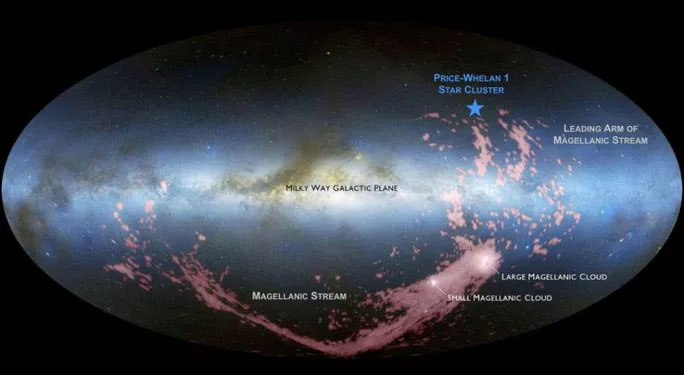Discover thousands of 'strange objects' from other galaxies surrounding us
The team, led by Adrian Price-Whelan scientist from the Flatiron Astrophysics Computing Center (New York, USA), has identified a series of unknown stars present at the edge of the galaxy. Milky Way contains Earth.
Analyzing the bands of light transmitted to Earth from 27 typical stars, the scientists realized that the unusual metal content showed that they were not made from materials belonging to the Miky Way.

Milky Way (green) between the neighboring galaxies and the Magellanic Stream.
This means that they were not born in a galaxy that contains the Earth, but were born in another galaxy, and then somehow invaded our galaxy. It is estimated that several thousand invading stars are wandering the Milky Way.
Further analysis, they found their origin - from Small Magellanic Cloud and Large Magellanic Cloud, two "neighboring" galaxies . These stars are like a peculiar set, made of the most unusual elements in their home galaxy and have very low metal content.
In addition, they may spawn the first branch of the Magellanic Spring . The Magellanic Spring is a giant cloud connecting the Small Magellanic Cloud and the Large Magellanic Cloud with a very long "tail".
However, there is much evidence that Magellanic Spring is not dense enough for star formation, so if strange stars form from here, there must be the mysterious hand of the Milky Way.
Our galaxy is a massive galaxy with enormous gravity. Gases from some "flow" at several points in the Milky Way can create "ram pressure," a kind of shock wave, that collides with other forms of natural galactic gas. This ram pressure , combined with the gravity of the Milky Way, can compress the gas in the Magellanic Spring enough for it to agglomerate, become dense enough to form odd young stars.
In the end, strange stars, like those born from nowhere, choose the Milky Way itself as their home. This result also shows that the dreamy Magellanic Stream may lie close to us, which is expected slightly, only about 90,000 light-years away.
- News aggregation or week 4/10
- Discover strange objects on Saturn
- Detecting the galaxy seems to not exist
- Discover 'living fossil' galaxies in the universe
- Detecting a group of 'ghost galaxies'
- Discover the birth of ancient galaxies
- Stunned disclosure of technology to identify cosmic galaxies
- NASA discovered the giant galaxy surrounding the cosmic black hole
- Appearing strange objects flying in the sky of Saigon
- Strange objects fell in Tuyen Quang and Yen Bai
- Discover a giant galaxy and a great black hole away from the Milky Way
- Video: Strange objects in the American sky
 Van Allen's belt and evidence that the Apollo 11 mission to the Moon was myth
Van Allen's belt and evidence that the Apollo 11 mission to the Moon was myth The levels of civilization in the universe (Kardashev scale)
The levels of civilization in the universe (Kardashev scale) Today Mars, the sun and the Earth are aligned
Today Mars, the sun and the Earth are aligned The Amazon owner announced a secret plan to build a space base for thousands of people
The Amazon owner announced a secret plan to build a space base for thousands of people